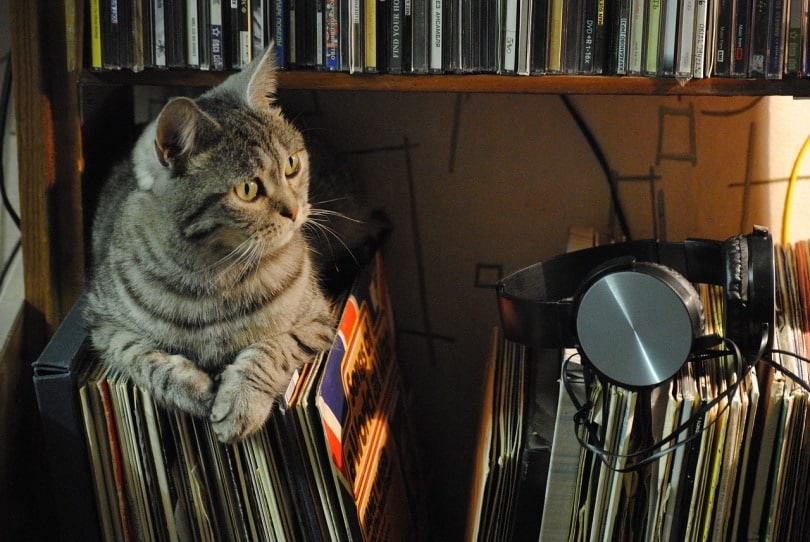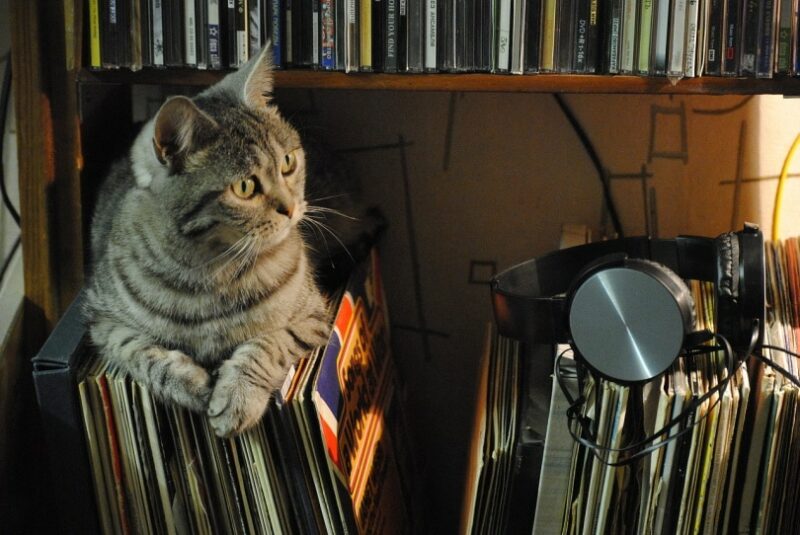With cats having been adored for many millennia, it’s no surprise that there are numerous songs dedicated to them. You can find all sorts of songs throughout the decades that describe many people’s experiences with cats. Some people write about how beautiful their cats are, while others will sing about how unpredictable they can be.
It’s impossible to mention all the existing songs about cats, so we’ve compiled a list that contains a wide variety of cat songs written and produced by all kinds of artists. Here are some wonderful songs about cats that you’ll love listening to with your cat this year and beyond.
Top 20 Songs About Cats
1. “The Love Cats” by The Cure
This song was written by Robert Smith and was first created as a parody song. However, it became very successful and ended up being number 7 in the Top 10 hits in the UK. The song is a mix of jazz, new wave, and pop, and it has a catchy, upbeat tone.
Cat fans will love this song even more when they watch the music video. There are multiple cats in every frame, and the band members are also seen dancing around in cat costumes.
2. “Kitty” by The Presidents of The United States of America
“Kitty” was supposedly inspired by a real cat that Chris Ballew used to live with at his apartment in Boston. The song talks about a man wanting to pet an outdoor cat. However, the cat scratches him, and the cat is left to spend the night outside.
The music video was shot from a cat’s perspective. It starts with a cat running around the neighborhood and ends with one of the band members giving them cat food before they run off again.
3. “Cat People (Putting Out Fire)” by David Bowie
This song was released in 1981 and faced commercial success. It topped music charts in the UK, US, New Zealand, Norway, and Sweden. It’s also considered to be one of the best recordings by David Bowie in the 1980s. The song was edited several times, and you can find several different versions of it.
4. “Pads, Paws & Claws” by Elvis Costello
This song was written by Elvis Costello and Paul McCartney and was recorded and released in 1989 in Costello’s album Spike. The album was Costello’s 12th studio album, and it was the top fifth album on the UK Albums Chart.
Despite being an upbeat song, the lyrics of “Pads, Paws & Claws” talk about a tumultuous relationship. If you like the song, you may appreciate listening to its extended version.
5. “Satellite Moments (Light Up the Sky)” by Charlie Fink
“Satellite Moments (Light Up the Sky)” doesn’t explicitly mention anything about cats, but it was written and recorded for the original motion picture soundtrack of A Street Cat Named Bob. This movie was based on a memoir written by author James Bowen.
Bowen and Bob’s story is a classic case of a cat adopting a human. Bob kept returning to Bowen’s apartment until Bowen officially took him in. Bob and Bowen became well-known on the Internet, as multiple videos of them busking in Covent Garden were uploaded.
6. “Stray Cat Strut” by Stray Cats
“Stray Cat Strut” was released in the UK in 1981 and in the US in the following year. It just missed placing in the Billboard Hot 100 chart by landing at number 109. However, Stray Cats’ next single, “Rock This Town,” made the top 10, and the band’s record company decided to re-release “Stray Cat Strut.” The song’s second release debuted at number 43 and peaked at number 3.
7. “My Cat’s Name Is Maceo” by Jane’s Addiction
This song was inspired by Perry Farrell’s cat, Maceo. It’s a playful song about their bond and describes how Farrell first met Maceo and what life with Maceo is like.
Maceo was named after jazz horn player Maceo Parker. When Jane’s Addiction decided to update the demo version of this song, they enlisted the help of Maceo Parker. The horn instrumentals that you hear in this version were played by Maceo Parker himself.
8. “Everybody Wants to Be a Cat” from The Aristocats
This song is a classic and beloved by Disney fans and cat fans alike. Its jazzy, upbeat tune accurately depicts how carefree and playful cats can be. The bright and fun music and animation are also a welcome break from the cats navigating the streets while trying to return home. Once you listen to this song, it’ll be difficult to get its catchy chorus out of your head.
9. “Cool Cat” by Queen
“Cool Cat” was released in 1982 and was included in one of Queen’s most experimental albums, Hot Space. Fans of Queen and music aficionados had mixed opinions about this album, but a few of Queen’s biggest hits were included in it. “Cool Cat” was never performed live, but it has remained a favorite among fans. The song’s lyrics are open to interpretation, but Freddie Mercury did state that the song was inspired in part by his love for cats.
10. “The Rum Tum Tugger” by Andrew Lloyd Webber
There are many hits from the musical Cats, but many fans appreciate “The Rum Tum Tugger” because of its playful lyrics. Many cat owners have experienced the fickle nature of their cats, but they still find them to be charming and love them anyway. It’s a relatable song with a catchy melody that both cats and humans can appreciate and enjoy together.
11. “Three Cool Cats” by The Coasters
“Three Cool Cats” is a classic written in 1958 by Jerry Leiber and Mike Stoller. It was made even more popular when The Beatles recorded it for their audition at the Decca Studios. They also did live performances of it several times, and it was eventually added to The Beatles Anthology series.
This song has been covered by several other artists. It was translated into French and recorded by Richard Anthony, and the Japanese rock band the 5.6.7.8.’s also recorded their own version for their 1996 EP Bomb the Twist.
12. “I Tawt I Taw a Puddy Tat” by Mel Blanc
Tweety’s signature line was composed into an entire song in 1950. This song depicts the famous dynamic between Sylvester and Tweety. It saw great success as it reached number 9 on the Billboard pop chart in 1951. Despite being a novelty song for a cartoon character, it was covered by a few notable artists, including Helen Kane and Danny Kaye.
13. “Phenomenal Cat” by The Kinks
“Phenomenal Cat” is a song about a whimsical flying cat that has traveled to many different places. During his travels, the cat finds the secret of life and decides to settle down and eat heartily for the rest of his life. The song is reminiscent of Victorian fairy tales and has a playful tone. Many fans of The Kinks are fond of this song, as it does a great job of capturing the essence of a carefree cat.
14. “50 Something Cats” by Deadmau5
“50 Something Cats” was released in 2017 on Deadmau5’s Stuff I Used to Do album. This song includes many fun elements, including recordings of Deadmau5’s own cats meowing. Deadmau5 seems to be a cat fanatic, considering the fact that he has several songs that are related to cats or have sound bites of cats incorporated in them. So, exploring his albums is usually a fun endeavor for fellow cat fanatics.
15. “Hello Meow” by Squarepusher
“Hello Meow” is a fast and upbeat electronic song that was released by Squarepusher in 2006. It’s the opening song for his album Hello Everything. The song first starts by sounding like an ordinary electronic song, but a fun bass solo eventually emerges in the second half. It matches the energy of a playful cat and is the perfect song to play whenever your cat has a case of zoomies.
16. “Cats” by The Living Tombstone
“Cats” by The Living Tombstone is a song that went viral nearly a decade ago and recently resurfaced due to a remix that was released earlier this year. The song has a loyal fanbase and has many parody entries of people interpreting the line of meows featured as the song lyrics. The first YouTube upload of the song was 20 minutes long, but you can now find 2-minute-long versions along with extended edits of the song that are 10 hours long.
17. “Honky Cat” by Elton John
“Honky Cat” was co-written by Elton John and Bernie Taupin and was the opening track for Honky Chateau, which was released in 1972. The song talks about a country boy who wants to move to the city. Many listeners love the song’s upbeat, funky vibe, and it faced commercial success upon its release. It reached number 8 on the US Billboard Hot 100 and Number 31 in the UK.
18. “The Kitty Cat Song” by The Troggs
“The Kitty Cat Song” was released in 1966 in the Troggs’ album, From Nowhere. The song talks about a cat owner who provides so much for their cat, but the cat doesn’t really reciprocate the owner’s affection. It has a catchy hook that’s sure to get stuck in your head, and many cat owners will be able to relate to the song as their own cats play hard to get with them.
19. “Sometimes I’m Alone” by The Kiffness
“Sometimes I’m Alone” is a song that was produced by Youtuber, The Kiffness. The Kiffness is known for taking viral internet videos and creating songs with them. “Sometimes I’m Alone” is a song that was made using the sound clips of a video of a cat that sounds like they’re saying, “Sometimes, I’m alone.”
The song has over 10 million views on YouTube. If you enjoy it, you can find several other songs by The Kiffness that feature other viral cats.
20. “Black Cat” by Janet Jackson
“Black Cat” was released on Janet Jackson’s fourth studio album, Janet Jackson’s Rhythm Nation 1814. It was the sixth single released from that album and was written by Jackson and produced with Jellybean Johnson.
The song was special because it was the first one in which Jackson received sole writing credit. It plays with the well-known superstitions of cats having nine lives and black cats being bad omens and signs of misfortune.
 Conclusion
Conclusion
Songs about cats span through all kinds of genres, and many different artists have written about a wide range of experiences with cats. There’s also a cat song for any kind of mood. So, make sure to update your playlist and add these amazing songs about cats. Your cat will love listening to these cat-dedicated tunes with you.
See also:
Featured Image Credit: hrypov, Pixabay
Contents
- Top 20 Songs About Cats
- 1. “The Love Cats” by The Cure
- 2. “Kitty” by The Presidents of The United States of America
- 3. “Cat People (Putting Out Fire)” by David Bowie
- 4. “Pads, Paws & Claws” by Elvis Costello
- 5. “Satellite Moments (Light Up the Sky)” by Charlie Fink
- 6. “Stray Cat Strut” by Stray Cats
- 7. “My Cat’s Name Is Maceo” by Jane’s Addiction
- 8. “Everybody Wants to Be a Cat” from The Aristocats
- 9. “Cool Cat” by Queen
- 10. “The Rum Tum Tugger” by Andrew Lloyd Webber
- 11. “Three Cool Cats” by The Coasters
- 12. “I Tawt I Taw a Puddy Tat” by Mel Blanc
- 13. “Phenomenal Cat” by The Kinks
- 14. “50 Something Cats” by Deadmau5
- 15. “Hello Meow” by Squarepusher
- 16. “Cats” by The Living Tombstone
- 17. “Honky Cat” by Elton John
- 18. “The Kitty Cat Song” by The Troggs
- 19. “Sometimes I’m Alone” by The Kiffness
- 20. “Black Cat” by Janet Jackson
- Conclusion










